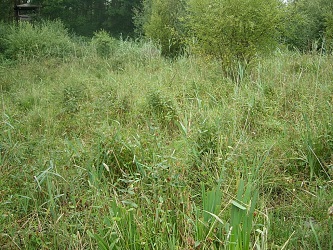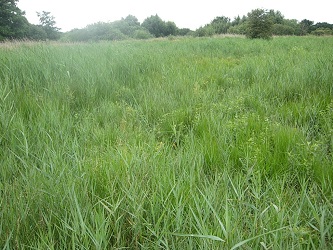Current ISIS code: W314
Previous assemblage name: W122, or W314 rich fen.
Linked assemblage: W313 mesotrophic fen
Description of habitat typically supporting the assemblage: This assemblage type is characterised by a number of groups, but especially two-winged flies and beetles.
W314 assemblages include aquatic open water species and terrestrial species associated with stands of tall monocots. They are best expressed in permanently wet habitats. They are more widely distributed than W313 assemblages.
The assemblage type is mainly restricted to topogenous mires and fens. Many sites are in floodplains or at lake margins and subject to water level fluctuations. Nevertheless, the substratum rarely dries out completely. The best examples of this assemblage type are found on peat in stands of Phragmites or Cladium or the wetter areas of fen meadow. Elements of this assemblage type can also occur widely at the margins of ponds and ditches in beds of tall monocots on a wider range of substrate types.

The larvae of Donacia, Notiphila and Erioptera squalida are closely associated with emergent wetland plants, and have adaptations to obtain oxygen by plugging their spiracles into the plant stems, although only Donacia larvae are actually herbivorous. Many of the sciomyzid parasitoids and predators of wetland snails require shallow water or fluctuating water levels that bring potential prey within reach of ovipositing females. Shallow water either over the bottom sediments or over dense submerged plants is also essential for most of the fly larvae which respire through ‘rat-tails’ (Ptychoptera) or floating posterior spiracles (Odontomyia, Oplodontha).

Potentially important environmental impacts
- Change in frequency and severity of flooding. Climate change (rainfall),
- Change in management by grazing, cutting or burning leading to ecological succession to carr, or conversely to a sustained reduction in vegetation.
- diffuse pollution (nutrient enrichment), site management (hydrology and vegetation structure)
- Reductions in the extent of surface wetting, or dropping of wetness class figures.
Sampling & assessing the assemblage
Standard sampling protocols apply
Target groups: Beetles & bugs
Fieldwork methods: ground-searching, pond netting
Alternative methods: pitfall trap grids
Season: spring and summer
Target groups: Flies
Fieldwork methods: spot-sweeping, sweep-netting
Alternative methods: water trap grids
Season: spring and summer
Discrimination of conservation quality: good
Default target: 11 species
